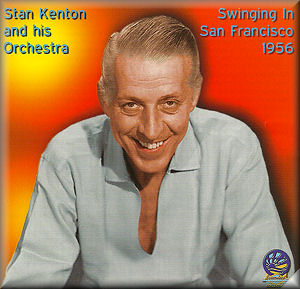1. What's New
2. My Old Flame
3. Kingfish
4. Street of Dreams
5. Royal Blue
6. Theme and Variations
7. I Concentrate on You
8. Evening (Rendezvous At Sunset)
9. Stompin' at the Savoy
10. Collaboration
11. El Congo Valiente
12. La Suerte de los Tontos
13. Under a Blanket of Blue
14. Swing House
15. Stan Kenton introduces the Orchestra
16. Artistry in Rhythm
Ed Leddy, Lee Katzman, Dennis Grillo, Phil Gilbert, Tom Slaney - Trumpets
Bob Fitzpatrick, Kent Larsen, Jim Amlotte - Trombones
Kenny Shroyer -= Bass trombone
Irving Rosenthal, Joe Mariani - French horns
Jay McAllister - Tuba
Lennie Niehaus - Alto sax
Bill Perkins, Richie Kamuca - Tenor saxes
Pepper Adams - Baritone sax
Stan Kenton - Piano
Ralph Blaze - Guitar
Don Bagley - Bass
Mel Lewis - Drums
This recording dates from 1956, the same year that Stan Kenton issued the notable albums Stan Kenton in Hi-Fi and Cuban Fire. Thankfully, Kenton was past his pretentious City of Glass era and had returned to leading more conventional big bands, similar to those with which he first made his name. These were distinguished by their punchiness and the high quality of their sidemen - and the same is true of this CD, released to coincide with Michael Sparke's new book This is an Orchestra!
The band is forceful from the very start, powered by Mel Lewis's drums. What's New has a fine solo from altoist Lennie Niehaus - as do several other tracks, such as Street of Dreams. My Old Flame was feelingly arranged by Marty Paich and makes good use of the French horns.
Royal Blue shows that the band could swing with the best of 'em, and Pepper Adams's baritone sax is prominent here. Other outstanding tracks include Stompin' at the Savoy, which pulls out all the stops after a restrained opening. Ralph Blaze solos on guitar in this Bill Holman arrangement. Swing House lives up to its name, with an outspoken solo from tenorist Bill Perkins. There are also reruns of former Kenton favourites, like Pete Rugulo's Collaboration and (of course) Artistry in Rhythm.
Some critics tended to be sniffy about some of Stan Kenton's offerings. This is understandable in the case of his more grandiose projects but few criticisms can be made of more unassuming sets like this one, which illustrates big-band jazz at near its very best.
Tony Augarde
